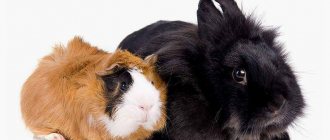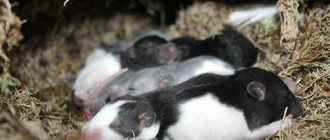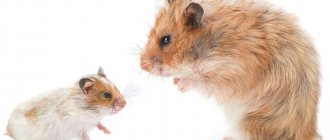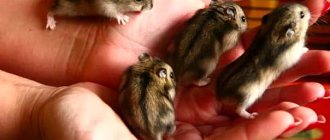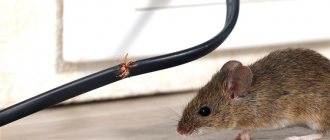Rats make fantastic pets for a variety of reasons - not the least of which is that they are adorable, intelligent and love to interact with people. However, there is one potential downside that puts some owners off: While rats have a sweet and friendly personality that you can fall in love with, they don't live long compared to other animals.
What life expectancy should you expect from pet rats, and how can you determine the age of a rat? In this article we will reveal the answers to these questions.
Lifespan
Experts say: the average age of a decorative rat is 1.5-2 years. With good care and the absence of pathologies, individuals can live up to 4 years. But if an animal survives its 4th birthday, then this is considered a unique case in nature. Therefore, the owners’ claims that their pets lived to the age of five are very doubtful. Moreover, there are no officially registered animals at this age.
The lifespan of pets is influenced by their living conditions. Rats experience stress from the noise of household appliances, and they are negatively affected by cigarette smoke. The main factors that reduce the life expectancy of animals are improper feeding and lack of attention to the pet.
How many years do rats live in nature and at home?
Every novice breeder should be prepared for the fact that decorative rats do not live long. Therefore, before getting a small rodent as a pet, it is worth weighing the pros and cons several times.
At the genetic level, the life expectancy of wild and domestic rats is the same, and is about 3 years. However, in practice, pasyuki live much shorter - on average up to one and a half years. The decrease in life expectancy of wild rodents is associated with living in unsanitary conditions, attacks by predators and advanced cannibalism (in the absence of other food sources).
At home, with proper care (kept clean, properly selected diet, timely treatment), decorative rats can easily live up to 2.5-3 years. However, among fluffies there are long-livers who have lived up to 4 years.
Comparison with human age
Rats grow very quickly. It is believed that at one and a half months the cubs already reach maturity. The child's body is formed before this period of approximately 12.5 years.
Article on the topic: Guinea pig allergy in children and adults: symptoms and treatment
The period of social maturation in rats, which is characterized by complete independence, ends at six months. By human standards, this is comparable to a child reaching adulthood.
A rat's age of 1 year is approximately 30 years in human years. In the future, each month of a pet’s life can be roughly equated to 2.5 years. For example, a three-year-old pet reaches the age of 90 years by human standards.
Attention! Menopause in females occurs at 15-18 months, which corresponds to a human age of 48-55 years. This means that offspring no longer appear after this period.
What factors does it depend on?
Experienced breeders know how long rats will live at home - this largely depends on the pedigree of the animals. In other words, the lifespan of a house mouse is directly related to genetics.
If parents are sick, they will not have healthy children. Weak children are also born from close relatives. These children live short lives and often get sick. Only healthy animals with the desired coat pattern and color are selected for crossing.
Accordingly, in order for pet rats to please their owners for a long time, it is advisable to purchase them in kindergartens, where specialists monitor the reproduction and treatment of their charges.
In addition to the child’s pedigree, future nursery owners will be told how to care for them, what they can and should be fed, what vaccinations they received and what needs to be done.
A healthy and rich diet for your pet will also ensure a long and happy life. Human food and junk food can cause illness and premature death in an animal.
Do not spoil your pet with chips, sweets and other similar treats.
The living conditions of pets are very important, so it is necessary to provide rats with everything they need.
Growth rate
Changes in little rat pups are observed daily:
- On the 3rd day the ears appear.
- Teeth appear on days 8-10.
- After 2 weeks, the nipples of females become visible.
- In the third week, the eyes open and the body becomes covered with fur.
The period of childhood in animals is very short, which is confirmed by the following:
- Within 10 days, the pups grow to the size of an adult mouse.
- After a little more than three weeks, the animals begin to feed on their own.
- After 30 days, the cubs leave the parental nest.
Subsequently, the rats grow until the age of 6 months. After this, they gradually mature and reach their maximum size at about a year.
Description
The Dumbo rat is a small decorative animal that has disproportionately large, low-set ears.
Representatives of this breed differ from ordinary rats in the shape of their ears, which come in two types:
- in the form of a plate;
- in the form of a bud.
European buyers prefer animals with ears in the form of buds. The maximum size of a well-fed pet's body is 20 cm, and the weight of an adult can reach 400 g. Boys are much larger than girls. The animals have a round head with an elongated, pointed muzzle. Eyeballs are round. Some representatives of this breed have a thick, fleshy tail, and some have this part of the body completely absent.
Animals have a short life span, which does not exceed 5 years. The average life expectancy is 3 years.
Distinctive features of a young rat
To approximate the age of a rat, you need to weigh it. At the same time, the weight of the male and female is different. When purchasing a pet, you can approximately determine its age, taking into account fixed weight parameters. For the female they are:
- At 2 months 150-200 g.
- At 3 months 210-250 g.
- At 4 months 260-290 g.
- At 5 months 300-340 g.
When choosing a male, the basic weight indicators change upward:
- At 2 months 160-220 g.
- At 3 months 230-310 g.
- At 4 months 320-410 g.
- At 5 months 420-490 g.
Posts 1 page 4 of 4
Share12012-04-26 18:56:09
- Author: Krisik 888
- Moderator
- From: Moscow
- Registered: 2012-04-08
- Invitations: 0
- Posts: 117
- Respect: +9
- Positive: 0
- Female gender
- Age: 35 [1984-04-05]
- Time spent on the forum: 14 hours 43 minutes
- Last visit: 2013-06-08 23:26:47
- Pets: Rats with a litter, soon I will be able to sell the cubs to whoever needs them
- From: Moscow
The sex of a rat is most easily determined by its tail, and its age by its teeth. Rodents of different ages have different colored teeth, and different tail fluffiness and also a different color.
Floor
The surest way is that in males the testicles (or testes) are clearly visible under the tail, and in females the nipples are clearly visible. At the age of up to 4 weeks, it may be impossible even for an expert to determine the baby’s age. The tail of a young male is white or orange-pink in color, with a uniform coat of hair, including the “bare” part of the tail. Or there may be lighter pink circles on the tail. But it’s pink, never white. The tail of a young female is usually a little bushier with white circles. It can also be almost completely white, off-white or beige. It is important that the pattern on the tail is clearly white. In males the tail is a richer pink color, in females it turns white. By six months, the male's tail becomes a rich orange/dark pink color. By about 7-8 months, the female’s tail is often covered with brown transverse stripes. Males of variegated colors even have a spotted tail.
Age
It is impossible to accurately determine the age of the rat. There are some indicators based on which you can determine the age of a rodent up to a year, and then approximately. After a year, you can only tell that the rodent is more than a year old - by its bright, dark-dark-dark orange, or even red, teeth. Plus they have a more mature character than children.
1. Very small rodents of dark or variegated colors usually have pink teeth. This is a rat up to 2 months maximum. 2. Baby rats of the Rex and Fuzz breeds up to 3-3.5 months old have a so-called “cap” - a half-naked place on the head or face. Adult molted rodents of the same breeds have more naked and half-naked places on their bodies. Not all babies of these breeds have a hat. 3. Young rats have completely black eyes, the iris is not visible. The iris gradually brightens, and by 5-8 months (sometimes by a year), a white rim appears around the eye. 4. The fifth toes on the rat’s front paws can be a very relative indicator. Before the first molt (up to 3-3.5 months), they are small or absent at all. After molting they become larger. 5. In females, the tail acquires brown transverse stripes by 7-9 months; in males, the tail becomes orange by six months of age.
Differences between old individuals
After six months, difficulties arise in determining the age of the animal during the weighing process. To do this, you need to take into account various external characteristics. You should pay attention to the length of the animal’s tail. If it is equal to the length of the body, then the animal is definitely more than a year old.
Article on the topic: Chinchilla or guinea pig: who is better, who to get for a child
In addition, the following signs indicate maturity:
- Dull and sparse fur, sticking out in some places.
- Rough skin on the tail with a large number of keratinized flaking areas.
- A hunched body, indicating the absence of a fatty layer on the back, which is always present in young individuals.
- Long incisors with ground back.
Increased life expectancy
You can extend your pet's life with proper care. The animal should have a spacious cage. It should provide for the presence of all the necessary accessories to maintain his physical activity in order to prevent muscle atrophy. These are ladders, a running ring, shelves, etc. It is important to remember that rats are social animals that require increased attention and care.
In addition, emerging diseases should be treated promptly to prevent the development of chronic pathologies. To do this, if there is any change in your pet’s behavior, you should visit a veterinary clinic that has a veterinarian on staff. He will diagnose and prescribe the correct treatment.
Rats are interesting pets that can become true friends. They are quite comparable to cats and dogs. The only thing that upsets many animal lovers is the short life of pets.
How to extend the life of a pet?
The lifespan of a decorative rat largely depends on nutrition. The following expert recommendations will help you create the right diet for your pet:
- Feeding rats in large portions is unacceptable - this can lead to obesity and rapid death of the animal.
- Food for pet rats should be rich in antioxidants - the presence of free radicals in the body contributes to the development of diseases and accelerates the aging process.
- When purchasing food, you need to choose only the one that is intended specifically for rats.
Feed
Another important factor is care and attention. Rats do not like high temperatures or cold, so it is necessary to install a house for them in a warm, dry room, without drafts, but away from radiators or heating devices
The house itself should be large enough so that its resident has plenty of free space to move around.
If the TV is often on in the room or music is played in it, it is best to move the rat house to another warm but quiet room. Rats do not like the frequent presence of strangers or animals.
Communication is no less important for rats: in nature, rodents live in groups, so they have a hard time withstanding loneliness. It is best to buy not just one pet, but 2 or 3, so that they can communicate not only with people, but also with their own kind
Little rats. Development and rearing of rat pups
1 period
Rats are born naked, blind, with closed ears, undeveloped limbs and a short tail. Body weight ranges from 4.0 to 6.5 g. They are helpless. All that baby rats can do during the first hours of life is suck. But they suck actively and grow quickly. The weight of a newborn animal reaches 3-6 g, depending on the number of individuals in the litter. Rat cubs grow and develop somewhat slower than hamsters. During the first days, the cubs cannot be handled; they can only be examined visually. Newborn rat pups feed on mother's milk, which contains 8.7% protein, 9.3% fat and 3.7% lactose (in human milk the protein content is 1.6%, fat - 3.3%, lactose - 6, 8%).
Article on the topic: Keeping two guinea pigs together: how to introduce them and what to do in case of fights
2nd period
Newborns' ears open on the third or fourth day after birth. On the fourth to sixth day, they develop a soft coat. On days 8-10, rat pups begin to teethe. By 10 days of age, the cubs' lower incisors have erupted. Molars appear later, 19-40 days after birth.
3rd period
Eye opening occurs on the 14th-17th day. To establish sex and examine the cubs at the end of the second week, they can be removed from the nest for a short time in the absence of the female. At this time, sex can only be determined by the presence of nipples in females, because the testicles of males still lie in the abdominal cavity and are not visible. Cubs are most active at the age of 8-20 days, but at this time great care is required in handling them, since their actions are not yet fully coordinated and they may fall to the floor. By day 16, the pups are completely covered with hair. In the second week of life, newborn females develop breast nipples. They are absent in newborns.
4th period
By day 21, the pups leave the nest and begin to eat food from the feeder. At the age of 25-28 days, the rat pups are placed in separate cages. Young rats require not only their mother's milk, but also contact with their mother, which gives them experience, security and warmth. Young rats that are sold too early remain small and get sick more quickly. It is possible to separate cubs from their mother at an age when they have reached, for example, the size of a large house mouse.
The growth of rats, which lasts 11-12 months, is influenced by many factors, but the main one, of course, is nutrition, which should be mixed and varied. Feeding young animals follows the same principle as adults, but fresh greens, sprouted wheat grains, fish oil and animal feed should be added to the diet. To create friendly relations with baby rats, you need to pick them up more often in the absence of the female, starting from a very early age.
Article on the topic: Decorative rabbit or guinea pig, which is better to have at home?
Thus, within three weeks, animals ready for independent life grow from defenseless naked lumps. The intensive growth of rat pups requires careful adherence to the feeding and maintenance standards of their mothers. During the suckling period, females should receive plenty of fluids and adequate feeding with sufficient protein, mineral salts and vitamins. Rats, as well as other small rodents, are characterized by different growth of individual parts of the body. The limbs and ears finish growing first - by the time they leave the nest they reach the sizes characteristic of adult animals. The tail takes a little longer to grow. By one and a half months, the weight indicators of the internal organs and brain have stabilized. By this time, the reproductive organs of females and males are finally formed, and already at the age of 5-7 weeks a young female can become pregnant, which is extremely undesirable for such a young creature.
The growth of rodents is greatly influenced by the level of feeding. With severe protein starvation, rat pups grow more slowly and mortality increases. Such animals give poor offspring in the future. Clean water should always be in drinking bowls - lack of drinking for a long time negatively affects the health of animals and their offspring. Young rodents need more food. With an animal weighing 10-14 g, the amount of food it eats per day is on average 70-80% of its body weight, and in some cases it can reach 100% or more. With age, young animals gain weight, and their need for feed changes accordingly.
Healthy foods
for baby rats 1-3 months: Cottage cheese, boiled chicken bones, boiled fish, apples, bananas, milky corn.
Should be limited
: broccoli, lettuce, boiled liver, yeast, egg yolk.
Harmful products
: champignons, tomatoes, cucumbers
How to extend the life of a pet? Recommendations for owners
It is very important to treat all diseases in a timely manner and prevent them from becoming chronic. Not everyone understands the anatomy of rats, and even fewer people know about possible diseases. In this case, you can contact a veterinary clinic; now almost all specialized clinics have a doctor who treats rodents directly - a ratologist
In small towns, it will most likely be difficult to find such a specialist, but even an ordinary veterinarian can easily diagnose the disease and prescribe therapy
In this case, you can contact a veterinary clinic; now almost all specialized clinics have a doctor who treats rodents directly - a ratologist. In small towns, it will most likely be difficult to find such a specialist, but even an ordinary veterinarian can easily diagnose the disease and prescribe therapy.
In addition to health, it is important to pay attention to the maintenance of your pet; for a comfortable life, rats require a spacious cage, which will be equipped with everything necessary
The litter you choose for your cage is also important. Many people are not aware that woody ones are not desirable for use in rat cages. This is due to the content of essential oils in the tree, which can cause allergic reactions or diseases of the ENT organs.
When buying a new pet, you should isolate it from other pets for a month so that the animal undergoes adaptation and adapts to foreign bacteria. To do this, it is worth placing the cage in a room where other animals will not have access.
Conditions for keeping rats and cage hygiene
Life expectancy is closely related to the hygiene and living conditions of decorative rats, for example:
size of the home - the more animals, the larger the area should be
Females require tall cages, while males, on the contrary, prefer a larger area; accessories - ladders and shelves are necessary to maintain physical activity; couple - it is important not to forget that in the wild these animals live in packs, and it is best to keep several individuals at once (of the same sex - unless you plan to become a breeder); walks - by purchasing a walking ball, you will provide the opportunity for even greater activity of the rodent, and besides, it is safe; care - rats are social animals, they become attached to members of the household and require attention and care. If you can provide the rodent with all the necessary conditions for a comfortable life, you will contribute to its long and happy life. If you can provide your rodent with all the necessary conditions for a comfortable life, you will contribute to his long and happy life.
If you can provide your rodent with all the necessary conditions for a comfortable life, you will contribute to his long and happy life.
| Necessary | Running wheel; shelves; ladders | walking ball | Cage dimensions | Proper nutrition |
| What does it affect? | Prevention of excess weight; prof muscle atrophy | Safe walks, additional physical activity | Promote a stable emotional background, space for physical activity | Disease Prevention |
Proper nutrition
Life expectancy in the wild directly depends on the nutrition of the rodent, often this is insufficient or poor nutrition:
- Foraging for food in landfills.
- Feeds on small animals and insects.
- The predominance of plant foods.
- Cannibalism - in conditions of hunger, rats often eat their relatives.
Settling in cities or near them, many rats die from the poison that people spread to fight animals.
For a long and healthy life, a rat should eat about 80% grains and about 20% vegetables/fruits/greens. There must be constant access to clean, usable water.
Young rats should be fed boiled meat and eggs at least once a week. Sometimes you can pamper them with nuts. Sprouted grains have a tonic effect and prevent many diseases, so they are also recommended to be added to the diet of decorative rats.
Age of a rat by human standards
Today it is customary to “project” the age of animals onto humans by comparing them. This diagram is very approximate, but may be useful for pet owners.
During childhood, animals grow extremely quickly. At the age of 6 weeks (one and a half months), the animals become sexually mature. In humans, this is observed by the age of 12.5 years. In both cases, fertilization of adolescents who have not yet fully formed is extremely undesirable.
It is very harmful to parents who are not ready to bear children. The offspring will not have full health.
At 5-6 months the animal matures. It is ready to reproduce its own kind without harm to health; by human standards, this is 18 years of age.
From this moment on, the age of the rat can be calculated, equating it to that of a human. To do this, use the formula: just multiply the months lived by the rat by 2.5. The result is a figure indicating the approximate corresponding human age.
A one-year-old animal will be “humanly” 30 years old (12*2.5=30). The formula calculates that the age of a one and a half year old is 45 years, a two year old is 60, a three year old is 90, and a four year old is 120.
Important! Menopause in rats occurs at 15-18 months, which corresponds to 48-55 human years. Having reached this period, the female is rarely able to bear offspring.
Rodent character
Those who have never met a rat face to face before can argue that rodents have a bad character. And only the owners of tailed sneaks can say with confidence: this is a loyal and intelligent pet . In terms of intelligence, ornamental rodents are compared to dogs. And for good reason: these are very smart animals.
Each of the domestic rats has a special temperament. You will never meet two identical eared ones. There are homebodies who like to sit in a cage and sleep all day long. Travelers also meet: do not feed such a pet bread, let him walk around the apartment. There are also “revolutionaries”: when they get free (on the carpet, for example), they strive to turn everything in their own way, steal small objects and carry trinkets from place to place.
The rat is an animal that can smile sincerely . Of course, its smile bears little resemblance to a human’s, but scientists have proven that by showing its lower teeth, the rodent expresses its joy at meeting you.
It is also curious that rodents readily respond to their own name. If a mouse gets lost in the bowels of the apartment, you don’t have to rummage through all the closets in search of it (as, for example, in the case of a selfish hamster). Calling the tailed one by name, you will immediately see its ubiquitous face. After all, communication with your beloved owner is more important than any intrigues.
And rats love to communicate . For her, there is nothing so much adored as “her” person. The rat will choose as its “own” the one who will pay it the most attention. She won’t offend the rest of the family, but she won’t give her a championship medal either.
By the way, adult pets treat strangers with caution. You may not recognize your polite mustachioed friend when he grabs the finger of a curious guest. Rats are terribly loyal and devoted, and in the event of a change of owner they do not even try to get used to a new person, often remaining an “abandoned loner” until their death.
Care and maintenance of domestic rats.
When examining a rat's character, the future owner can be given some advice:
- When buying a pet, be prepared to interact with it daily. Communication involves contact, play and hand feeding. This is the only way your “mouse” will be happy. Let your pet sit on your shoulder, lightly tease you, and steal small trinkets from you.
- Introduce your pet to all family members right away so that there are no misunderstandings later.
- Give your rat a name and speak to it often. The smart rodent remembers not only some words, but also perfectly captures the mood by the intonation of its voice.
- Equip the “hole” according to all the rules (they will be described below). This way you will avoid the animal’s constant attempts to escape from the cage. A rat, in love with its home, will happily return there after a walk.
- As you already understand, walks are mandatory for a rodent. Of course, you don't have to take your rat to the park. It is enough to let her out of the cage once a day. If you have a female, then it is not recommended to leave her unattended. The girls are very homely and their whole life consists of trying to “build” a nest. The material for the kennel will be your personal belongings, so keep a close eye on your pet if you are not ready to sacrifice socks as building material.

